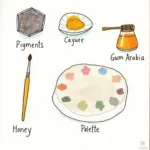Creating the perfect purple hue involves understanding the interplay of colors and choosing the right medium. Whether you’re aiming for a vibrant violet for your walls or a subtle lavender for a craft project, mastering how to get purple color opens a world of creative possibilities. Let’s delve into the fascinating world of purple and explore the various techniques to achieve this captivating color. You’ll be surprised at how easy it is to create a wide range of purple shades with just a few basic colors.
Mixing Red and Blue: The Foundation of Purple
The most common method of obtaining purple is by combining red and blue. However, the final shade depends significantly on the specific reds and blues you use. A warm red mixed with a cool blue might produce a different result compared to a cool red and a warm blue. For instance, using a crimson red with a phthalo blue creates a richer, deeper purple than mixing a scarlet red with a cerulean blue. Experimenting with different ratios and types of red and blue is key to unlocking a diverse range of purple hues. What colors together make purple? It’s all about the reds and blues! You can even learn what color does blue and purple mixed together make to deepen your purple or add complexity.
Exploring Different Mediums for Purple
The medium you’re working with also influences how you achieve and manipulate purple. The process of creating purple with paint differs from how you’d achieve it with dyes, inks, or even digitally.
Paints: A World of Purple Possibilities
Acrylics, watercolors, and oil paints each have unique characteristics that affect color mixing. The pigment concentration, transparency, and drying time all contribute to the final purple you achieve. With acrylics, you can build up layers of color to create depth and intensity, while watercolors allow for a more translucent and delicate purple. Oil paints offer a rich, vibrant purple with a slower drying time, allowing for more blending and manipulation.
Dyes and Inks: Vibrant and Translucent Purples
Dyes and inks offer vibrant and often translucent purple colors. They are particularly popular for fabrics, illustrations, and calligraphy. The process typically involves dissolving the dye or ink in a specific medium and applying it to the desired surface. The intensity of the purple can be controlled by the concentration of the dye or ink.
Digital Purple: Endless Hues at Your Fingertips
Creating purple digitally provides unparalleled control and precision. Using color pickers and sliders, you can define the exact shade of purple you desire by adjusting its hue, saturation, and brightness. Digital platforms offer an endless array of purple hues, from the palest lilac to the deepest violet. You might even discover how much did Fantasia get for the color purple in a completely different context!
Beyond Red and Blue: Unconventional Ways to Get Purple
While red and blue form the basis of most purples, there are other intriguing ways to create this color. For example, mixing magenta and cyan can result in a stunningly vibrant purple. You can also create nuanced purples by combining other colors with pre-existing purples. Adding a touch of white lightens the shade, while black deepens it. Experimenting with these unconventional methods can lead to unique and unexpected purple hues. Thinking about removing unwanted purple tones? Check out this article on how to get purple color out of hair.
Adding White and Black: Tints and Shades of Purple
Once you’ve achieved your desired purple hue, you can further modify it by adding white or black. Adding white creates lighter tints of purple, like lavender and lilac. Incorporating black produces darker shades, such as deep violet and eggplant. These variations allow for greater flexibility in matching your purple to specific design needs.
Conclusion
Understanding how to get purple color unlocks a vast spectrum of creative possibilities. From the classic combination of red and blue to more unconventional methods, achieving the perfect purple is a journey of exploration and experimentation. Whether you’re a painter, a designer, or simply someone who appreciates the beauty of this captivating color, the world of purple awaits your creative touch. Remember to explore further on what color does blue and purple make mixed together to broaden your understanding of color mixing.
FAQ
-
What are the primary colors used to make purple?
Red and blue. -
Can I make purple with other colors besides red and blue?
Yes, you can use magenta and cyan, or modify existing purples with other colors. -
How do I make a lighter shade of purple?
Add white to your purple mixture. -
How do I make a darker shade of purple?
Add black to your purple mixture. -
Does the type of paint affect the resulting purple color?
Yes, different paint types have varying pigment concentrations and properties that influence the final color. -
How do I make purple digitally?
Use a color picker and adjust the hue, saturation, and brightness. -
Where can I find more information on color mixing?
Numerous online resources and books provide in-depth information on color theory and mixing.
Need help with your color project?
Contact us! Phone: 0373298888, Email: [email protected]. Visit our showroom at 86 Cầu Giấy, Hà Nội. We offer 24/7 customer support.
